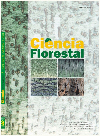
|
Ciência Florestal
Centro de Pesquisas Florestais - CEPEF, Departamento de Ciências Florestais - DCFL, Programa de Pós Graduação em Engenharia Florestal - PPGEF
ISSN: 0103-9954
EISSN: 0103-9954
Vol. 18, No. 3, 2008, pp. 307-314
|
 Bioline Code: cf08028
Bioline Code: cf08028
Full paper language: Portuguese
Document type: Research Article
Document available free of charge
|
|
|
Ciência Florestal, Vol. 18, No. 3, 2008, pp. 307-314
| en |
Composition and nutrient biological utilization efficiency in Atlantic Forest fragment in Pernambuco, Brazil
Espig, Silvana Andreoli; Freire, Fernando José; Marangon, Luiz Carlos; Ferreira, Rinaldo Luiz Caraciolo; Freire, Maria Betânia Galvão dos Santos & Espig, Darci Bacelar
Abstract
The vast majority of research on nutrients in natural forest is concentrated in the litter. In Brazil, in
Atlantic Forest, some investigations have been conducted in few locations such as Dois Irmãos Forest (PE),
Tijuca Forest (RJ) and Salão Dourado Forest (MG). In the present research, the studied area was
characterized as remaining of Atlantic Forest classified as slope, ombrofilous forest. The objective was to
determine by a phytosociologic study the ten species of most important value (VI) and to evaluate the Ca,
Mg, P, K and N nutrients contents in these species leaves, likewise to estimate leaf biomass and the efficiency of biological nutrient utilization, increasing the knowledge about Atlantic Forest residues in
Brazil. After determining the ten species of most important value, the largest circumference individuals at
1.30 m from soil surface (CAP) in each specie were sampled and the leaves from the intermediate part of the
trees top were collected, making a composed sample, being determined Ca, Mg, P, K and N contents. In this
study, the leaf biomass was estimate in each species and, to transform this biomass in kg/ha, the leaf
biomasses from the species' individuals were added in the area. The nutrient contents in leaf biomass from
the species (kg/ha) were achieved multiplying the content (g/kg) by leaf biomass (kg/ha) in each specie. The
biological utilization efficiency was calculated considering the ratio between the leaf biomass and the
nutrient contents from species. The leaves nutrient contents were in a decreasing order N>Ca>K>Mg>P, but
in some species the K content was higher than Ca content. The leaf biomass of the ten most important value
species was 3.3 t ha -1 which represented 24.5 % of the total spot leaf biomass (13.4 t ha -1). Schefflera morototoni

(Aubl.) Maguire, Steyerm & Frodin showed the most leaf entrance of Ca e Mg while Helicostylis tomentosa

(Poepp. & Endl.) J.F., Macbr. showed the best results for P, K and N in the spot. The biological
utilization efficiency presented the sequence P>Mg>K>Ca>N.
native forest; leaf biomass; leaf nutrient content
|
| |
| pt |
Composição e eficiência da utilização biológica de nutrientes em fragmento de Mata Atlântica em Pernambuco
Espig, Silvana Andreoli; Freire, Fernando José; Marangon, Luiz Carlos; Ferreira, Rinaldo Luiz Caraciolo; Freire, Maria Betânia Galvão dos Santos & Espig, Darci Bacelar
Resumo
A maioria dos estudos sobre teores de nutrientes em matas naturais se concentra na serapilheira. No
Brasil, em Mata Atlântica, foram realizadas pesquisas na Mata de Dois Irmãos/PE, na Floresta da Tijuca/RJ e
na Mata Salão Dourado/MG. Neste trabalho, a área em estudo constitui um remanescente de Mata Atlântica,
enquadrando-se como Floresta Estacional Semidecidual. O trabalho objetivou determinar, por meio da
fitossociologia, as dez espécies de maior valor de importância (VI), avaliar os teores dos nutrientes Ca, Mg,
P, K e N nas folhas dessas espécies, estimar sua biomassa foliar e determinar a eficiência de utilização
biológica desses nutrientes, ampliando assim, o conhecimento sobre os remanescentes de Mata Atlântica no
Brasil. Metodologicamente, depois de definidas as dez espécies de maior VI, amostraram-se os indivíduos de
maior circunferência a 1,30 m do solo (CAP) de cada espécie, e coletaram-se as folhas da parte intermediária
da copa, formando uma amostra composta em que foram determinados os teores de Ca, Mg, P, K e N. Neste
estudo, estimou-se a biomassa foliar em cada espécie e para transformar essa biomassa em kg/ha, somaramse
as biomassas foliares dos indivíduos da espécie encontrados na área. O conteúdo de nutrientes na
biomassa foliar das espécies (kg/ha) foi obtido multiplicando-se o teor (g/kg) pela biomassa foliar (kg/ha) de
cada espécie. A eficiência de utilização biológica foi calculada pela razão entre a biomassa foliar e o
conteúdo de nutrientes das espécies. Os teores dos nutrientes, nas folhas, apresentaram a seguinte ordem
decrescente N>Ca>K>Mg>P, porém em algumas espécies o teor de K foi maior do que o de Ca. A biomassa
foliar das dez espécies de maior VI foi de 3,3 t ha -1, e representaram 24,5% da biomassa foliar total (13,4 t
ha -1) do fragmento. A espécie Schefflera morototoni

(Aubl.) Maguire, Steyerm & Frodin foi responsável pelo
maior aporte via foliar de Ca e Mg e Helicostylis tomentosa

(Poepp. & Endl.) J.F., Macbr. pelo de P, K e N
no fragmento. A eficiência de utilização de nutrientes apresentou a seguinte ordem P>Mg>K>Ca>N.
floresta nativa; biomassa foliar; teor de nutrientes
|
| |
© Copyright 2008 - Ciência Florestal
Alternative site location: http://cascavel.ufsm.br/revistas/ojs-2.2.2/index.php/cienciaflorestal/index
|
|
